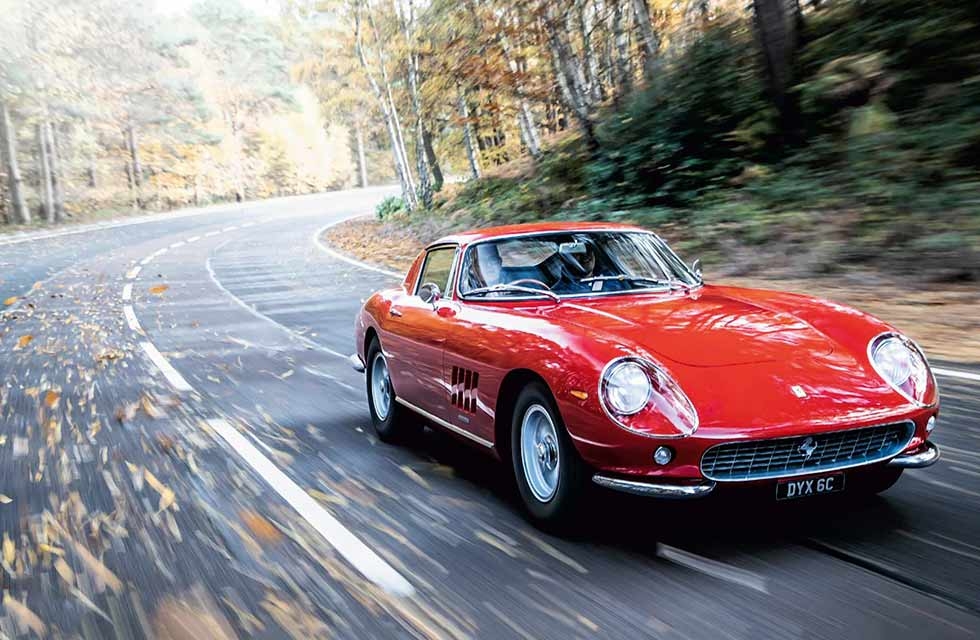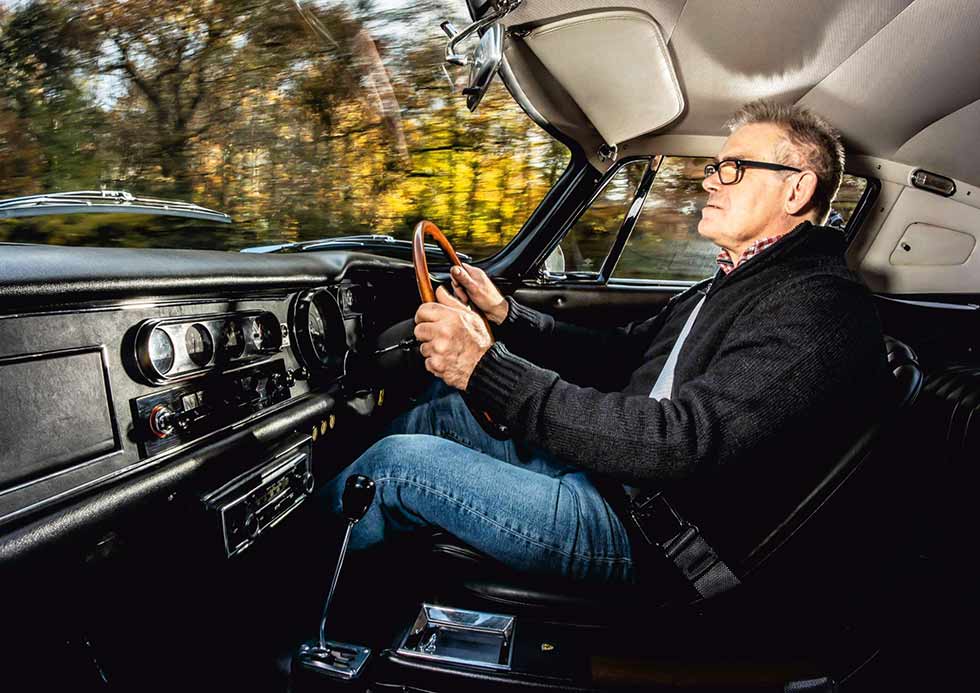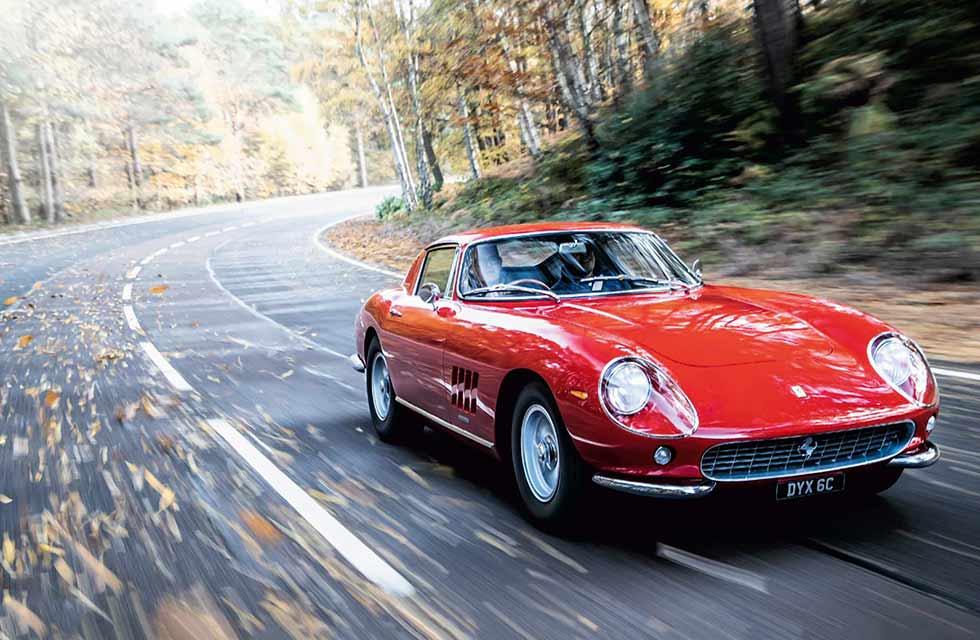
The List Your dream drive made real. It’s a fair old leap from a Saab 96 to a Ferrari 275GTB, but someone’s got to do it. Step forward James Douglas. Words Ross Alkureishi. Photography Charlie Magee.
We put a reader in his £2m dream. ‘That noise is just awesome’ – a reader takes on the £2m dream Ferrari 275GTB
‘The proportions are just perfect’
The List – We treat reader James Douglas to our most expensive dream-drive yet: a day with the beguiling Ferrari 275GTB
The heavy rain has not long passed and in its wake is a stunningly vibrant rainbow. Apt, because somewhere over it – or in this case under it – dreams really do come true. At least for retired primary school headteacher and Classic Cars reader James Douglas they do. ‘If there’s one car on my dream drive list that I never, ever thought you’d put me in, it’s this,’ he admits, as the muscular rear end of DK Engineering’s Ferrari 275GTB emerges onto the tarmac at the Longcross test track. ‘I’ve seen them before, more often in film or print, but in the metal the proportions are just perfect – I can’t believe it’s finally happening.’

Me neither; it’s been two years in the making. In fact, the sales manager of one company intimately involved with old prancing horses said it’d never take place, stating, ‘We have owners scared to drive them because of the value.’ That’s what happens when a simple motor car becomes one part legend, one part objet d’art – normal rules no longer apply. Of course for ‘simple motor car’ read, 3286cc Colombo V12, exquisite Pininfarina lines, one of 460 two-cam examples of the 275GTB produced and always-lusted-after plaything of the rich, famous and successful since its arrival back in 1964.
‘There’s not a panel on it that isn’t right… it looks beautiful, but in a purposeful, slightly aggressive manner’
‘I think it looks incredible from any angle,’ says James. ‘There’s not a panel on it that isn’t right to me.’ Sitting gleaming on the wet tarmac, it’s hard to disagree with our reader’s analysis. ‘I particularly like the long bonnet and squat Kamm tail. The intake strakes on the front wing are echoed by those on the rear three-quarter panel and looked at from behind, the cockpit narrows considerably, almost like a boat; that helps to emphasise the rear haunches, which give the car such a muscular appeal. Again, the proportions are just perfect; it looks beautiful, but in a purposeful, slightly aggressive manner. The grille is surprisingly wide but doesn’t detract from the smooth flowing lines of the bonnet and the faired-in lights, because it’s tucked down lowand at a slightly oblique angle.’
His design soliloquy over, he adds, ‘You could sit it in your front room and never tire of looking at it.’ True, but I remind him it’s now time to drive it. His grin is instant as he pops the door and settles into the driver’s leather bucket seat. ‘I’m pleasantly surprised,’ he says. ‘It’s comfortable and feels almost modern in here. I like the detailing; discreet chrome strips around the switches and dials, not lots of bling but subtle and classy – almost understated.’

He primes the triple Weber carburettors with a couple of throttle pumps before all 12 cylinders fire on the key turn, flooding the cabin with a portentous rumble before dying down to a calm and even tickover. Seatbelt secured, James depresses the clutch – ‘that’s incredibly heavy’ – before slotting the gearlever into first on the dogleg ’box. ‘I can’t reach the handbrake,’ he exclaims.
Ah, that comedy Sixties Italian design element. ‘It’s tucked a long way forward on the side of the transmission tunnel, almost as if Ferrari decided you didn’t need it until you stopped.’
With the handbrake issue resolved we’re off, gently trundling onto the high-speed outer track. ‘The controls all feel heavy, but in a positive way. The accelerator and brake are very close together and surprisingly large, so I have to be wary so as not to stamp on both at once. One thing though, the feel of this thin wooden Nardi steering wheel is an unexpected pleasure; I imagined it would be less comfortable than a chunky, modern wheel but it’s not at all.’
Our first ten minutes allow James to acclimatise to the feel and nuances of the 275GTB; its essential fluids get up to temperature and the tarmac is beginning to dry out. ‘It calls on you to be deliberate in your actions,’ he says. ‘The gearlever won’t be hurried, but time it just right and it feels great as it slots through the gate. ’
‘Listen to that noise… it’s just awesome. The low-down growl has morphed into more of a howl’
After a few more laps, there’s an abrupt change in the Colombo’s engine note. A driver wearing a now somewhat enlightened visage accompanies its distinct hardening, and a now rapidly rising rev counter needle. ‘Listen to that noise… it’s just awesome. The throttle travel is so long and heavy that on my previous somewhat tentative laps, I thought I had it down when it was only about half way. The low-down growl has morphed into more of a howl.’ An approaching kink in the track sees James’ first serious engagement of the anchors. ‘Oh, those feel a bit wooden,’ he comments, mildly alarmed. ‘There’s not a lot of feel, and it’s quite an effort to slow the car. Better get them warmed up, too.’
Back on a straight and it’s loud pedal down again, followed by a hefty shove on the brakes, which he repeats a number of times.
‘Below 2000rpm the engine sounds a bit lumpy and grumpy, but above that it smooths out. It’s purposeful though, subtly aggressive rather than overtly so – if that isn’t an oxymoron! Inside the cabin the noise remains pleasantly, rather than uncomfortably loud – even under the hardest acceleration. It’s music to my ears, and I could listen to it all day long. Like all the really great engines, I love the tone changes at different revs.
‘I’m also surprised just how easy it’s been to jump in and drive it, without drama or fuss. It’s not taken too long to get used to it and is less frenetic than I thought it’d be, but you still get the feeling it could be pretty-wild when necessary.’
No doubt; although, according to period road tests, a little less so than the marginally hairier 250GT SWB it replaced. Put that down to the incorporation of all-round independent suspension – a first for a Ferrari – that lent the chassis a more progressive feel.
At the same time, a five-speed gearbox – the marque’s first transaxle – endowed it with significantly longer grand touring legs than its predecessor, something that’s clear to our driver. ‘There’s no doubt I would be comfortable driving it over a long period of time and over large distances.’
As the track’s control tower looms large, he peels off and parks up. We pop the long bonnet up, admiring the attention to detail underneath and taking the chance to discuss both his initial thoughts on the Ferrari and his own tastes in classic cars. ‘You originally had me down to drive a blue NART Spider,’ says James. ‘And while I wouldn’t have wanted to seem ungrateful, I’m glad that opportunity fell through. The looks of the original are just right, and for me it doesn’t quite work as a soft top. Ferrari didn’t intend that, hence the 275GTS. Noise and looks are also very important for me in any vehicle. This ticks both boxes, but the NART wouldn’t have. There’s also the question of colour, I’m not wedded to the idea that Ferraris have to be red, but some Ferraris must be.’
Agreed, it’s definitely the 275GTB’s best hue, and this particular example still wears its original paint. Back in the cabin I reach behind his seat and grab the car’s information sheet, handing it him. He blows out a long whistle, as he takes in the information, ‘It’s a three owner car that’s totally original and has never been restored, and that 51,478 mileage is absolutely correct,’ he says.
I add to that by informing him that it’s from the proprietors of DK Engineering, part of the Cottingham family’s personal collection. ‘That’s real trust. The value of the car doesn’t bother me, although I’m certainly aware of it. I suppose being on a quiet track rather than the public road has helped ease any such concerns – more important is its originality, and the fact that it’s their car.’ Back on it, as we thunder round the track the 275GTB’s quad ANSA tailpipes leave little golden cyclones in their wake, as fallen leaves are furiously kicked up. I know this as I catch James smiling at the spectacle, and turn round myself. ‘I moved my seat a little closer when we stopped, so I can get a better push on the clutch,’ he explains – all the better for barrelling on. He’s also lowered his window, but there’s no need for an explanation as to why.
‘It’s quite confusing with the spec for this model,’ admits James. ‘Three-carb, six-carb, long-nose, short-nose, quad cam, alloy… but I must say, you got it just right with this one.’ That’s something owner David Cottingham alluded to in our telephone conversation the previous day, and I repeat his thoughts for James, ‘Yes, the four-cams have a fantastic engine, but they don’t have the same feel on the road as the early cars, which have metallic bushed wishbone eyes and not rubber, plus a relatively solid-mounted engine as in a 275GTB competition car.’
It’s time for James to sample the Ferrari’s feel in more detail, so we turn off onto the track’s inner sanctum – The Snake, a tortuous, twisting rollercoaster of a road full of wild camber changes, tight corners, sweeping bends, and rapid inclines and descents. It’s a true test for any car. Unfortunately, areas of the road surface remain decidedly moist under tree cover; couple that with rotted leaf matter on the road surface and it’s tiptoe time.
‘It feels just as well planted here as out on the high-speed area,’ says James. ‘I like the steering and the sensation is that it works well with the throttle to manage the rear end. I get the feeling that if you push on, it’d remain beautifully balanced between oversteer and understeer. I’d love to explore that further with less subtle inputs of throttle and steering, but respect and these road conditions, as well as the fact the car is worth seven figures, definitely rule that out.’ Would his Saab 96 excel in this? ‘Most definitely, I’ve never driven a car that’s quite so at home in the snow and slippery conditions.’
Our time with the DK Engineering two-cam 275GTB is drawing to a close, so it’s time for a final few high-speed laps and some closing thoughts on the car. James is still driving with mechanical sympathy, but revving the engine harder and savouring every last musical nuance of each double-declutch. ‘Seeing the car in the metal, driving and hearing it has most definitely lived up to the dream; I am delighted by that, as dreams are often tainted by reality. Everything is right about it; the looks and the noise, combined with the experience behind the wheel, make the whole thing sublime. I haven’t got a bucket list, but if I had thiswould be a pretty big tick!’
What about its value today – is it ridiculous, overblown or spot on? ‘That is such a hard question to answer. I suppose if I were incredibly wealthy I would say yes it is worth the money. If you consider a David Hockney painting from 1972 recently sold for $90 million, then this piece of automotive art from 1965 is very good value. Not only is it art, it also sounds and goes as well as originally intended. They say Enzo Ferrari called the Jaguar E-type “the most beautiful car in the world”, but for me it’s always been the 275GTB – it’s more muscular and aggressive, so more of a heavyweight. I don’t currently buy lottery tickets for the Euromillions; hell, maybe I should pop down to the newsagents to get one!’
As the control tower looms large once again, James turns and says: ‘One last lap?’ Sure, it’d be rude not to.
Thanks to: David and James Cottingham of DK Engineering (dkeng.co.uk)
TECHNICAL DATA FILE SPECIFICATIONS 1965 Ferrari 275GTB
Engine 3286cc, sohc-per-bank V12, three Weber 40DCN/3 carburettors
Max Power 280bhp @ 7600rpm
Max Torque 217lb ft @ 5000rpm
Transmission Five-speed manual, rear-wheel drive
Brakes Dunlop discs
Suspension Front and rear unequal-length wishbones, coil springs, telescopic dampers, anti-roll bar
Steering ZF worm and roller
Weight 1100kg (2425lb)
Performance 0-60mph: 6.0sec.
Top speed: 153mph
Fuel consumption 15mpg
Cost new £7063
Classic Cars Price Guide £1.1m-£1.7m
The Ferrari’s willingness to brave leaves on the track ultimately outdid James’ Kicked-up Kamm tail minimises drag and looks great to our reader’s eyes James waxes lyrical over the Colombo-designed overhead-cam V12. James and Ross think Francesco Salomone got the 275GTB spot on. The gateway to a five-speed transaxle. Retired head teacher James underwent intense re-education in the 275GTB. ‘Yes, I’d feel comfortable driving this long distance.’ Now he needs a lotto win.
JAMES’ DREAM DRIVE LIST
Aston Martin DB6
‘For me the prettiest Aston – I love the sawn-off Kamm tail.’
Jaguar 3.8 S-type
‘Grew up watching these being written off in The Sweeney.’
Citroen SM
‘Looked so futuristic; even nearly 50 years on I still think it’s amazing.’
Maserati 3200GT
‘Reasonable reliability, wonderful looks, good performance and excellent comfort – in a Maser!’
Lancia Stratos
‘The noise it made and the skill required to drive it made it a legend.’
Saab 96 V4 (works rally spec)
‘Stig Blomqvist won the ’1971 RAC Rally in one – I’d love to drive a works car.’
Alfa Romeo Giulia
‘Hired one a couple of years ago and wasn’t disappointed – one of the prettiest cars ever made.’
Riley Pathfinder
‘First car I can remember, as my dad had one – powerful and imposing.’
Ferrari 275GTB
‘Awesome. If I could have just one car off my list, it’d be this.’
Alfa Romeo 8C
‘The most beautiful car made in recent times’
JAMES’ CAR CV
Campers, Alfas and plenty of Saabs
PEUGEOT 205GTI
‘One of my favourite cars, a real hoot to drive and, apart from a faulty alternator at 35k miles, no trouble at all up to 105k miles when I sold it.’
VOLKSWAGEN TYPE 2 (T3)
‘Although it was woefully underpowered we had great fun in it. Now replaced by a T4 camper with the more potent 2.5-litre turbodiesel.’
ALFA ROMEO 159 Q4
‘My first Alfa was a 156 2.5, followed by a GT with the 3.2 Busso V6, another 156 and then this 159 Q4 with the GM Holden-based V6.’
SAAB 96 V4
‘My fourth 96, extensively modified with sport/ rally parts: a different crank makes it 1740cc, it has a Weber twin-choke and a gas flowed head.‘
NUMEROUS OTHER SAABS
‘I’ve also had a 95, three 99s, a 9000 Turbo and a 9-5. My 99 Turbo was wicked fun thanks to the untamed nature of its early turbocharger.’







